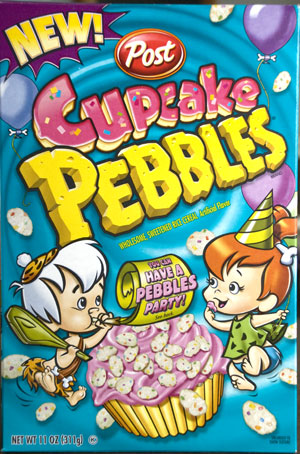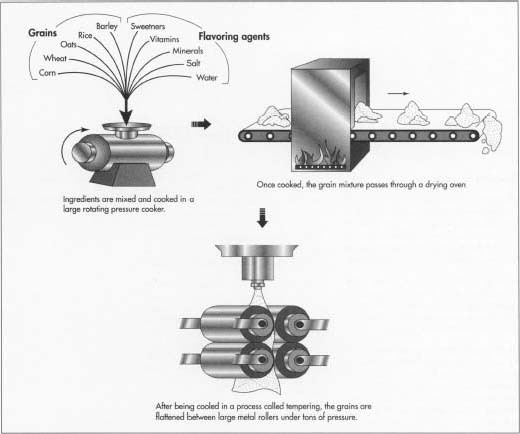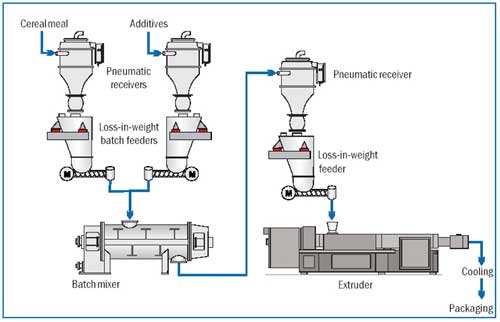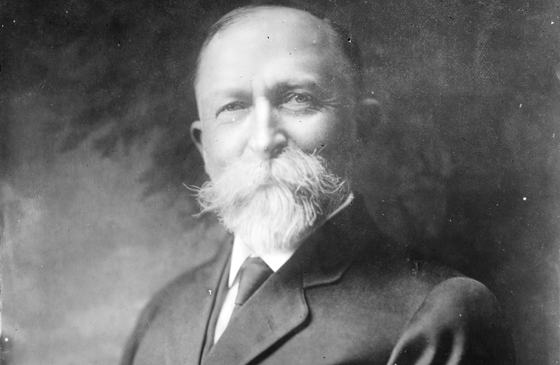When Neolithic farmers figured out how to cultivate wheat, millet, oats and other wild grasses some 10,000 years ago – they created the first steady food supply we’d ever known.
But a supply of barley for the winter is a bit different from the bulk pack of Cupcake Pebbles from Costco.

What is cereal?
For thousands of years, many traditional cultures have eaten cereals in the form of porridge. Traditionally, these were whole or ground grains (and sometimes legumes such as peas or starches such as tapioca) that were soaked in water and allowed to ferment. Historically, porridge was often seen as poor people’s food, or the kind of cuisine you’d get in prison.
Flintstones notwithstanding, the breakfast cereals of today don’t look much like their traditional ancestors.
Breakfast cereal: A brief history
Dr. James Caleb Jackson created the world’s first cold breakfast cereal in 1863. It was whole wheat flour and water.
He baked it, broke the pieces up, and then baked them again. Ta-da – he had “Granula”. Granula had to be soaked overnight in order to be chewed.
Later, food manufacturers began to add vitamins and minerals to cereals, and people began to view cereals as health-promoting rather than as prison or peasant cuisine.
During World War II, the government encouraged vitamin and mineral enrichment of foods to improve the nation’s health. This continues today, with mixed results. In 1988, Kellogg’s saturated about 30,000 packages of Rice Krispies with excessive amounts of iron. Later that year, 28,000 packages of Mini-Wheat’s had too much vitamin A added.
How cereal is made
In general, when cereals are made, grains are processed into flour, cooked, mixed with other ingredients, dried, and shaped. Cereal can also be puffed, flaked or shredded.
Making breakfast cereal involves:
- mixing grains with flavouring agents and water
- cooking to gelatinize the grains’ starch, which creates the desired final texture and makes the grains digestible
- drying
- cooling/tempering, then pressure-flattening or passing through an extruder that makes shapes (rather like a big toothpaste tube)
- toasting and flaking


Here’s a schematic diagram of some of the machinery involved. Yummy! Just like grandma used to make!

Cereal manufacturers use mechanical food texture analyzers to test the “crunchiness” of cereal. One of the reasons cereal is often sugar coated is to provide a layer between the liquid (usually cow’s milk) and the cereal to extend its crunch.
8 types of cereal processing
Beyond the basic cereal production process, there are eight distinct cereal processing categories:
1. Flaked cereals
A typical formula contains 100 pounds of grain, 6 to 12 pounds of sugar, 2 pounds of malt syrup, 2 pounds of salt, and enough water to achieve 28-32% moisture after cooking. Too much moisture reduces crunchiness. Too little moisture leads to breakage. Cooking time varies depending on the grain. Corn takes about 120 minutes, rice takes 60 minutes, and wheat takes 35 minutes.
Example: Corn Flakes.
2. Gun-puffed whole grains
Here, the grain must be cooked, followed by a rapid pressure drop in the atmosphere surrounding the grain. This releases steam from the grain as the pressure within the grain tries to equilibrate with the lower pressure surrounding it.
Rice and wheat are the only whole grains used for gun-puffing (corn can also undergo this process, but not in whole-grain form). Puffing can be done with single or multiple shot guns. Temperatures vary, staying above 400 degrees F. Puffed cereals rely on a coating (usually sugar) to maintain a crisp texture.
d: Golden Crisp/Sugar Crisp
3. Extruded gun-puffed cereals
The starting material is flour. Cooking takes place in the extruder, and then dough is formed and cast. Using modified food starch (e.g., like tapioca or potato starch) helps to obtain a high expansion volume and form a film on the cereal while keeping the fat content low. When the dough is cast, the desired shape is created, similar to pasta. Extruded cereals tend to have less browning than other varieties.
Example: Cheerios
4. Shredded whole grains
The grain is cooked, cooled, and tempered for up to 24 hours. After this, the wheat is squeezed between one smooth and one grooved roll. A comb runs along the grooved roll to separate the shreds.
Example: Shredded Wheat
5. Extruded and other shredded cereals
A blend of the extruded and shredded processes mentioned above.
Example: Life
6. Oven-puffed cereals
These cereals are usually rice or corn (or a mixture), and require very high temperatures (550 to 650 degrees F). For more on high cooking temperatures and processed carb foods, see All About Cooking & Carcinogens.
Example: Rice Krispies
7. Extruded expanded cereals
Similar to the extrusion process above.
Example: Cap’n Crunch
8. Granola cereals
A mixture of grains, sweeteners, fruits, nuts and other additives baked at 300 to 425 degrees F to achieve a light-brown color and 3% moisture.
Example: Umm… granola.
Why is cereal so important?
If you want to see America’s advertising expertise in action, walk down the cereal aisle.
Cereal was one of the first marketing panaceas, and we’ve taken the advertising bait. Cereal also kicked off our addiction to convenience. Forget about a 15 minute delay for rolled oats or a vegetable omelet. Cereal = open, pour, and hover. Ready in 30 seconds.
A few cereal consumption facts:
- We buy about 2.7 billion boxes of cereal each year, leading to annual sales of about $10 billion, making it one of the top three most popular supermarket products (behind beverages and bread). Per capita consumption of cold breakfast cereals rose from 4.4 pounds in 1939 to 14.3 pounds in 1997. By comparison, France consumes about 1.8 pounds and Canada eats about 9 pounds.
- The only countries that eat more cereal than the U.S. are England, Ireland and Australia.
- Kellogg’s, General Mills and Post make up 73% of the cereal market share. The top three most popular cereals are Cheerios, Special K, and Honey Bunches of Oats. About 20 new cereals are offered each year.
Yep, we love our breakfast cereals. In part, this is because we mistakenly think they’re good for us… and our kids.
But breakfast cereals marketed to children contain more sugar and salt than those for adults. Cereal manufacturers spend millions of dollars each year marketing to kids. During kids TV shows the top category of advertised food is cereal (beating out candy, snacks and fast food).
On average, 8 to 12 year olds see three cereal ads per day (about 1095 cereal ads per year). And you wonder why your 10 year old turns into a drugged up monkey while browsing the cereal aisle?
What you should know about cereal
Before cereal was invented, the U.S. was eating grease, flour (e.g., pancakes), pork, mutton, liver, kidney, pickled meats, and rich sauces for breakfast. As you might expect, many Americans were also battling indigestion, gout and constipation.
Religious folks were ready to intervene with a whole grain alternative to help with regularity and gut health. Oh, and they also wanted to get rid of meat at breakfast to “curb ungodly desires.”
Kellogg, cereal pioneer

John Harvey Kellogg helped lead the way. Kellogg was a Seventh Day Adventist who studied medicine, eventually writing books/articles. He recommended no drugs, no alcohol, and no tobacco, plenty of exercise, low calorie consumption, and low meat intake. This was revolutionary (in the 1890s).
He believed that optimal health started in the GI tract – so he also pushed bran consumption and daily enemas.
But before you become a Kellogg disciple – he also prescribed 12 pounds of grapes each day for people with high blood pressure and forced underweight patients to consume 26 milk feedings per day while lying motionless in bed with sandbags on their feet (seriously).
Kellogg began experimenting with cereal recipes based on Dr. James Caleb Jackson’s original mix. He combined wheat flour, cornmeal and oatmeal into various ready-to-eat cereal shapes and sizes.
In 1894, wheat flakes were developed by cooking ground wheat into dough and then flattening it between metal rollers. The flakes were then cooked and cooled. Kellogg called it “Granose.” Eventually, corn was also used. This began the cold cereal revolution.
In 1902, W.K. Kellogg (John Harvey’s brother) experimented with adding sugar to cereal. Between 1910 and 1925 sugar consumption doubled. Adding sugar to cereals increased sales and cereal companies began to focus on profit.
Not until the 1970s did parents question added sugars in cereal, and thus cereal names started changing.
- Sugar Crisp became Golden Crisp
- Sugar Pops became Corn Pops
- Sugar Smacks became Honey Smacks
Big Cereal and the business of breakfast
Cereal is big business. Each new cereal production technique was (and is) a marketing opportunity.
In the mid 1900s, food manufacturers wanted people to buy more cereal, so they did motivational research on flavours and textures. They modified the packaging to draw more attention to the cereal.
Eventually, the production of cereals became so secretive that factory tours were cancelled in the 1990s due to espionage.
It’s no surprise — cereal production takes a 12 cent bushel of grain and converts it to a product that sells for around four dollars… and most of the money is spent on marketing.
Cereal and health
In North America, we don’t eat whole grains much. One of these potential occasions is a bowl of breakfast cereal (the other major sources are popcorn and bread). Of all foods consumed for breakfast, cereal is the most common, making its way into about one-third of all breakfast occasions.
Data show that consuming commercial breakfast cereals can increase overall nutrient intake and lead to a healthier weight – when compared to those who skip breakfast. It’s hard to conclude much from studies on eating cereal and body weight, due to the multitude of other factors.
In the last decade, we’ve seen the introduction of cereal bars and cereal cafes.
Manufacturers have successfully convinced many of us that cereals are good for us, especially when “fortified” with added vitamins, minerals, and fibre. But ask yourself… why is all that good stuff missing in the first place?
Let’s look at what Honey Nut Cheerios, for instance, contains. I’ve taken the liberty of putting sugar sources in bold.
Whole grain oats, sugar, modified corn starch, honey, brown sugar syrup, corn bran, salt, corn syrup, oat fibre, corn syrup solids, tripotassium phosphate, canola and/or rice bran oil, guar gum, natural almond flavour, mixed tocopherols.
3/4 cup of Cheerios contains:
110 calories
190 mg sodium
2 g fibre (from added fibre)
1.5 g fat
22 g carbohydrate
9 g sugar
2 g protein
Let’s see… five types of sugar, for starters. And the fibre has to be added in.
I wouldn’t exactly call that healthy. By the way, go and measure 3/4 cup of cereal. I bet you’ll be surprised at how tiny it looks. Most folks could easily eat three times that and not notice.
The “healthy” cereals
Oats
Oatmeal was proclaimed in the 1800s to be one of the best soothers for an irritable stomach. In the 1920s, Quaker Oats began utilizing radio advertising to promote sales. The first instant flavored oatmeal was introduced in 1970 – less than 50 years ago. In the 1980s, Wilford Brimley started pushing oatmeal, and sales increased by 25%.
Cream of Wheat
Cream of Wheat was discovered in 1893 by a guy in North Dakota who was looking to save some money by cooking up “wheat leftovers” (the bran) as porridge.
Ralston
Ralston (endorsed by Dr. Ralston) wheat cereal originated as livestock feed. To bump up profits, it was eventually marketed as a cereal for humans.
Wheaties
I don’t know about you, but during my 7th grade basketball season, I made sure my mom bought Wheaties. Was this due to nutrition science? Nope. It’s because Michael Jordan was on the box.
The advertising push for Wheaties began in 1924. Interestingly, a survey in 1991 revealed that most American consumers didn’t realize Wheaties were made out of wheat.
Jim Fish, a former vice president of advertising for General Mills said, “Wheaties is no different from anybody else’s [cereal]; it’s just a product of unique and consistent advertising.”
Special K
This was invented in 1955. The 1950s was when TV advertising for cereals took off. The industry took advantage and Special K swept across the U.S. As you can see, TV ads for cereal in the 1950s and 1960s were riveting.
Kix commercial from the 1950s
Trix cereal commercial from the 1960s
Special K commercial from the 1970s
Cheerios commercial from the 1980s
Wheaties commercial from the 1990s
Froot Loops commercial from the 2000s
All Bran
In 1984, All Bran sales increased 41% when a TV commercial claimed that bran could decrease the risk of cancer.
Summary and recommendations
Most of us can acknowledge that a majority of cereals are edible entertainment. Cereal consumption usually has little to do with nutrition and a lot to do with advertising, characters, images, and convenience.
Cereal is one breakfast option that may contribute to optimal health/body composition… if the alternative is eating nothing. But always consider what your alternative option would be (for more on alternative breakfast options, see All About Breakfast).
Be aware that a majority of cereals have added sweeteners/preservatives, are highly processed, and are a concentrated source of energy (which can be helpful when trying in increase body weight).
If you eat cereal, use common sense when reading the ingredient label, and as always, don’t believe any of the information printed on the front of the box.
Extra credit
In 1898 C.W. Post tried developing a coffee substitute, but instead he sold it as breakfast cereal. It’s called Grape-Nuts — “grape” because it contained maltose, which at the time Post called “grape sugar.” And “nuts” because it tasted like nuts.
When cow’s milk pasteurization became standard in the early 1900s, cereal became more popular.
In the 1960s Post worked on freeze drying fruits for cereals. This allowed them to double the price of cereal. They started to actually deplete North American strawberry crops.
Lucky Charms were invented based on the inclusion of Circus Peanut marshmallow shavings in a basic extruded cereal.
Since cereals can break into bits and settle during transport – companies claim “Contents measured by weight, not volume,” on the front of the package.
In 1966, Quaker test marketed an entire Cap’n Crunch product line with cookies, snacks and shakes.
Food and beverage packaging is a major source of waste, accounting for 55% of global packaging waste.
In 2008, each percentage point of market share for cereals was worth approximately $62 million.
A cereal fortified with fluoride was tested in the 1950s by Post.
Cereal production lines can package 2 boxes per second.
In the 1990s cereal companies started printing and distributing coupons – this was done to increase sales.
Grains contain lectins. See All About Lectins for more.
References
Click here to view the information sources referenced in this article.
Eat, move, and live… better.©
The health and fitness world can sometimes be a confusing place. But it doesn’t have to be.
Let us help you make sense of it all with this free special report.
In it you’ll learn the best eating, exercise, and lifestyle strategies — unique and personal — for you.



Share